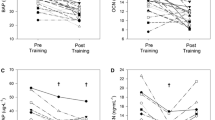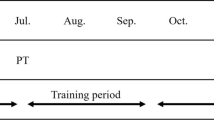Summary
We evaluated the effects of marathon running on bone metabolism in 23 noncompetitive athletes (15 women, 8 men, age range 23–55 years). The volunteers were studied 10 days before, immediately after, and 1, 3, and 5 days after the run. Serum osteocalcin levels were decreased on average by 20% (from 4.9 to 3.9 μg/liter, P=0.005) in men and by 10% (from 4.9 to 4.4 μg/liter, P<0.05) in women at the end of the marathon, with lowest osteocalcin levels (67–55% of the prerun levels) encountered 1 day after the marathon. The activity of bone alkaline phosphatase was decreased in women (from 66.3 to 62.3 U/liter, P<0.05) after the run, and this drop was detectable at each checkup after the run. Urinary excretion of calcium was lowered on average by 82% in men (from 2.8 to 0.5 μmol/minute, P<0.05) and by 76% in women (from 2.5 to 0.6 μmol/minute, P<0.005) after the run, but had already returned to prerun levels 1 day after the marathon. Urinary excretion of hydroxyproline tended to rise in both men and women, but the change did not reach statistical significance in either sex. These changes suggest a transient suppression in osteoblast function during the marathon.
Similar content being viewed by others
References
Bailey DA, Martin AD, Houston CS, Howie L (1986) Physical activity, nutrition, bone density and osteoporosis. Aust J Sci Med Sport 18:3–8
Lukert B, (1990) Osteoporosis: prevention and treatment. A review. Compr Ther 16:36–41
Daniell H (1976) Osteoporosis of the slender smoker. Arch Int Med 136:298–304
Parfitt AM (1983) Nutrition: the changing scene. Lancet 2:1181
Hale RW, Kosasa T, Krieger J, Pepper S (1983) A marathon: the immediate effects on female runner's luteinizing hormone, follicle stumulating hormone, testosterone and cortisol levels. Am J Obstet Gynecol 146:550–558
Yeh J, Aloia J (1990) Effect of physical activity on calciotropic hormones and calcium balance in rats. Am J Physiol 158:E263-E268
Cunningham J, Serge G, Slatopolsky E Avioli L (1985) Effect of heavy exercise on mineral metabolism and calcium regulating hormones in humans. Calcif Tissue Int 37:598–601
Vora N, Kukreja S, York P, Bowser E, Hargis G, Williams G (1983) Effect of exercise on serum calcium and parathyroid hormone. J Clin Endocrinol Metab 57:1067–1069
Bell N, Godsen RN, Henry DP, Shary J, Epstein S (1988) The effects of muscle-building exercise on vitamin D and mineral metabolism. J Bone Miner Res 3:369–373
Singer FR (1986) Metabolic bone disease. In: Felig P, Baxter JD, Broadus AE, Frohman LA (eds). Endocrinology and metabolism, 2nd ed. McGraw-Hill, New York, pp. 1452
Podenphant J, Larsen N-E, Christiansen C (1984) An easy and feliable method for determination of urinary hydroxyproline. Clin Chim Acta 142:145–148
Duda RJ, O'Brien FJ, Katzmann JA, Peterson JM, Mann KG, riggs BL (1988) Concurrent assays of circulating bone GLA-protein and bone alkaline phosphatase. J Clin Endocrinol Metab 66:951–957
Price PA, Nishimoto SK (1980) Radioimmunoassay for the vitamin K-dependent protein of bone and its discovery in plasma. Proc Natl Acad Sci 77:2234–2239
dessypris A, Kuoppasalmi K, Adlercreuz H (1976) Plasma cortisol, testosterone, androstendione, and luteinizing hormone in a non-competitive marathon run. J Steroid Biochem 7:33–37
Fellmann N, Bedu M, Giry J, Pharmakis-Amadieu M, Bezou MJ, Barlet JP, Coudert J (1989) Hormonal, fluid and electrolyte changes during a 72-h recovery from a 24-h endurance run. Int J Sports Med 10:406–412
Lukert B, Raisz L (1990) Glucocorticoid-induced osteoporosis: pathogenesis and management. Ann Int Med 112:352–364
Hahn TJ, Hahlstead LR, Baran DT (1981) Effects of short-term glucocorticoid administration on intestinal calcium absorption and circulating vitamin D metabolite concentrations in man. J Clin Endocrinol Metab 52:111–118
Author information
Authors and Affiliations
Additional information
Children's Hospital
Rights and permissions
About this article
Cite this article
Malm, H.T., Ronni-Sivula, H.M., Viinikka, L.U. et al. Marathon running accompanied by transient decreases in urinary calcium and serum osteocalcin levels. Calcif Tissue Int 52, 209–211 (1993). https://doi.org/10.1007/BF00298720
Received:
Revised:
Issue Date:
DOI: https://doi.org/10.1007/BF00298720




